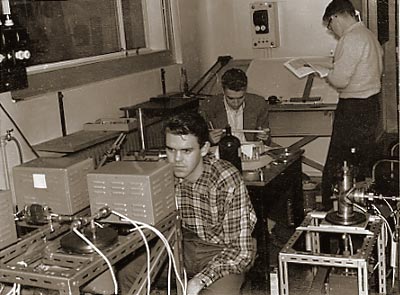Table of contents - Previous section - Next section
In 1908, 40 years before the foundation of Faculty of Science, a private German astronomer offered to donate his expensive astronomical equipment to Aarhus Municipality if the council would, in return, build an observatory where he himself could be director. The offer was accepted, and three years later, in 1911, in his inaugural speech for the new observatory, the city's mayor was able to mention that this was, perhaps, a small step towards a university in Aarhus. The observatory, which stands on high ground near Marselisborg Palace in the south of Aarhus, was designed by the architect Anton Rosen and named after the renowned Aarhus scientist Ole Rømer (1644-1710).
In the years around 1920, that is before the foundation of the University Association, great efforts were being made in Aarhus to build up a scientific milieu in the city. It was in this connection that a factory director, who was also a strong university supporter, made funds available for the purchase abroad of large collections of natural history specimens with a view to establishing scientific collections for study. Together with those smaller collections which already existed in the city, the new items, not least the zoological and mineral specimens, came to constitute the nucleus of the Museum of Natural History which was set up on the upper floor of the newly built school in Læssøesgade in 1921, and which got its own building some twenty years later, in a beautiful spot beside the lake in University Park.
The fact that the setting up of the Faculty of Science dragged on until 1954 (when the University of Aarhus had celebrated its 25th Anniversary in the previous year) was primarily due to the government's unwillingness to subsidise the development of more than one major faculty at a time. By 1953, the Faculty of Medicine was in full flow, so the following year it became possible to take on the establishment of yet another faculty. Three of the four subjects which would come to constitute the faculty in 1954 were already running at the University of Aarhus; Physics and Chemistry had constituted the foundation introductory subjects within the Faculty of Medicine since 1933, and Geography had been introduced within the Faculty of Arts in 1943. These three subjects were now supplemented by Mathematics, for which subject a new building was erected. The Department of Mathematics, which was built as an extension to the first University building from 1933, very soon became too small, and it was necessary to construct a new building. Naturally, this was also the case for Physics, Chemistry and Geography, which had all expanded quite quickly in terms of student numbers and subject areas. The foundation of the faculty also meant that Physics and Chemistry, while naturally retaining their roles within the medical studies area, were no longer exclusively "service subjects", but independent research and teaching subjects. In 1956, two years after the faculty was set up, the Municipality handed over the Ole Rømer Observatory to the Faculty of Science, and in the following year a professorship in Astronomy was introduced. A string of further subjects were later introduced, such as Geology, Biology, together with History of Science, Computer Science and, most recently, Sports Sciences. Following the end of admissions to the Geography course in 1985, the winding down of the Department of Geography began.
Of the museums in University Park, it is not only the Museum of Natural History that has a close working-relationship with the faculty (particularly through Zoology); the same applies to The Steno Museum - The Danish Museum of the History of Science and Medicine - which originally (as far as the museum's History of Science material is concerned) developed from the collection which had been founded in the Physics Department as far back as 1956, and as a consequence of which the department now bearing the name of The History of Science Department was introduced. The Steno Museum was opened to the public in 1994. In addition to the museums, there is also the Institute of Biological Sciences' 2,000 square metres of greenhouses in the Botanical Gardens, which anyone is welcome to visit during opening hours. In these five greenhouses, built during 1970-71, there is the opportunity to study no less than 4,000 different types of sub-tropical and tropical plants.
 Before the Faculty of Science was established in 1954, Physics and Chemistry had been part of the Faculty of Medicine, but now these subjects moved into the new faculty, and in 1956 Physics and Chemistry began to be taught as distinct subjects in their own right. From the first Physics class, the students seen working on a practical experiment are (from left to right): Poul Thomsen, Johannes Wilhjelm and Preben Østergaard Sørensen. (Photo: Knud Maack Bisgård. University History Committee). |